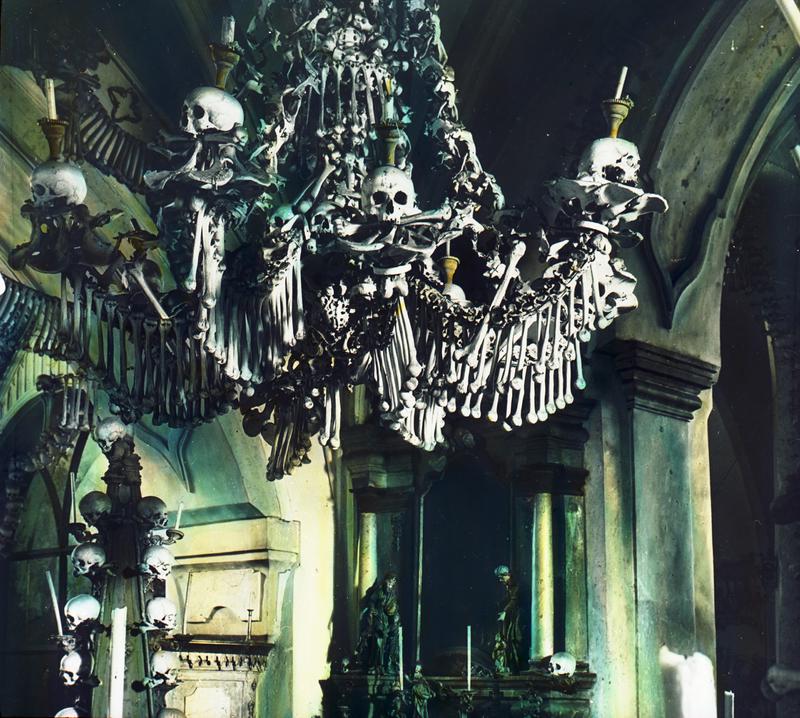Inside The Church Of Bones Made Of 40,000 Departed Humans
By | June 7, 2021

The Sedlec Ossuary, better known in popular culture as the Church of Bones, is a small chapel located in the town of Kunta Horra in the Czech Republic. As with any ossuary, the building is dedicated to housing those who have shuffled off this mortal coil, but the Sedlec is the only one on Earth to store the dead with such macabre theatrics and bizarre beauty. The bones of those long since passed are not simply stored but displayed in fantastically ornate designs, from chandeliers to candelabras and even a bone-crafted coat of arms.
But Why?
Back in the 1200s, when the region was known as Bohemia, an abbot named Henry went on a holy pilgrimage to Jerusalem. According to legend, he took soil from the very site of Jesus of Nazareth's crucifixion and returned it to the Church of All Saints in Sedlec, where he sprinkled it over the cemetery, consecrating the ground in an extremely rare and hallowed way. It made the land immensely important to 13th-century Roman Catholics. People were literally dying to get into such a revered and holy cemetery, which didn't pose much of a problem until the Black Death came knocking on Europe's door about a century later.

Plague, Religion, And War, Oh My
Out of the 40,000 skeletons in the Sedlec Ossuary today, an estimated 30,000 got there as a direct result of the Black Death, which still stands as the worst pandemic in human history, wiping out a horrific 60% of Europeans during the mid to late 1300s. Thousands more were added the following century thanks to the Hussite Wars, which pitted Protestant Hussites against Catholics in 1419. The only skulls displayed in a non-decorative way are the skulls of these fallen soldiers, which show in gruesome detail the cracks and gashes that 15th-century axes and maces could cause to the human head.
By the 1500s, the cemetery had way more bodies than it was ever meant to handle, so the ossuary was built to store the older deceased and make room for new ones. This may seem disrespectful by modern standards, but keep in mind these graves, especially those from the era of the Plague, were not the orderly, engraved, and maintained tombs we have today. The majority were huge pits which stored hundreds or even 1,000 bodies piled on top of each other with no record of who everyone was or even much of a way to figure out what skull matched which femur. People simply wanted to be buried in sacred ground and had no illusion of a pristine burial, so the ossuary delivered their final wishes of always remaining on the land that they'd revered so deeply.
In 1511, a monk was given the task of exhuming the bodies and moving them from the graves into the ossuary. It was an even more difficult task than it sounds: He was half blind, and all of the bodies had decomposed completely into skeletons, which have the tendency to fall apart without flesh to hold them together, so he decided the best way to fit everyone inside of the little temple was to stack them on top of each other, pyramid-style.

What's With The Candelabras, Though?
In the 1700s, Italian architect Jan Santini Aichel decided to spruce up the place by adding a new entrance and took the opportunity to add some decor to the little pyramids by allotting them each a crown for their tops. However, it was the bold move of creating extremely intense skull-and-crossbones-style candelabras that really set the stage for the macabre wonder that was to come.
In 1870, after being given free rein to "organize" the bones as he saw fit, woodcraftsman Frantisek Rint took inspiration from the bone candelabras and ran with it. He created skull garlands which hung from the ceilings, a chandelier which used every single bone in the human body to form its hauntingly beautiful design, and other fanciful yet disturbing imagery like skeletal angels.
Some have criticized his work for being disrespectful, as those who were buried obviously didn't sign up to be church decor, but others find the work awe-inspiring. Such morbid art was common in the 16th century, the time of the sentiment memento mori, a reminder that life is indeed fleeting and we all must die, no ifs, ands, or hip bones. Today, the Sedlec Ossuary is open to visitors and receives around 200,000 guests every year.

